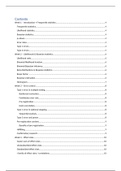Study guide
Edexcel A Level Geography 5: The Water Cycle and Water Insecurity - (Case Studies, Notes & Exam Questions)
- Course
- Institution
- Book
I achieved a high A in Geography at A-Level and these are my notes for the Water Cycle and Water Insecurity unit. These notes are incredibly detailed yet provide a good summary of the specification - containing over 30 pages with all the key information, facts and case studies needed to achieve th...
[Show more]





